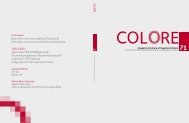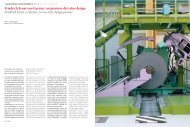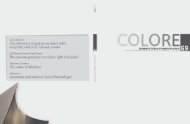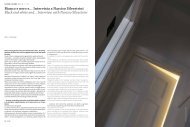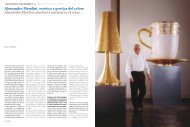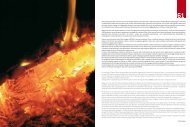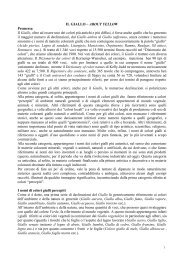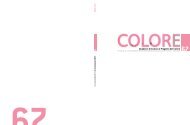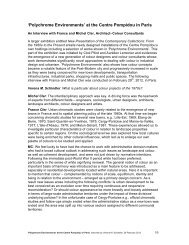Quaderni di Cultura e Progetto del Colore - Istituto Del Colore
Quaderni di Cultura e Progetto del Colore - Istituto Del Colore
Quaderni di Cultura e Progetto del Colore - Istituto Del Colore
Create successful ePaper yourself
Turn your PDF publications into a flip-book with our unique Google optimized e-Paper software.
CULTURA / CULTURE [ (1 + 2 ) 3 4 5 6 7 8 9 ]<br />
A proposito <strong>del</strong> marrone,<br />
omnipresente ma sottovalutato<br />
About the ubiquitous<br />
but academically neglected color named brown<br />
<strong>di</strong>/by : Lucia Ronchi<br />
foto/photo: Giuseppe Rosini<br />
1. La quoti<strong>di</strong>ana immersione nel marrone<br />
Il marrone è intorno a noi, colore essenziale nel nostro<br />
ambiente, eppure la Scienza <strong>del</strong>la Visione ha<br />
determinate le leggi <strong>del</strong>la funzionalità visiva senza<br />
considerarlo, <strong>di</strong>ciamo, dal punto <strong>di</strong> vista “accademico”.<br />
Diamo quin<strong>di</strong> il benvenuto ad un numero<br />
<strong>di</strong> COLORE de<strong>di</strong>cato al marrone, che oltre a presentare<br />
l’importanza dei vari impieghi <strong>di</strong> questo colore,<br />
è un pretesto per segnalare vari libri, nei quali gli è<br />
dato lo spazio che gli compete, anche se la sua presenza<br />
è stata sempre molto <strong>di</strong>screta.<br />
Per iniziare, con alcuni ovvii esempi, ricor<strong>di</strong>amo che<br />
viviamo praticamente “immersi” nel marrone.<br />
Nell’ambiente naturale abbiamo i tronchi ed i rami<br />
degli alberi, le <strong>di</strong>stese <strong>di</strong> terra arata ed una stagione,<br />
l’autunno, de<strong>di</strong>cata alla trasformazione <strong>del</strong> colore<br />
verde <strong>del</strong>le foglie, in un caduco marrone, passando<br />
attraverso le note manifestazioni <strong>di</strong> rosso,<br />
arancio e giallo.<br />
La pelle umana è rosacea, detta bianca nel Caucasici,<br />
ma che assume <strong>di</strong>verse varianti <strong>del</strong> marrone in<br />
seguito all’abbronzatura. Non <strong>di</strong>mentichiamo, tuttavia,<br />
la gran parte <strong>di</strong> umanità non caucasica, dove<br />
il colore <strong>del</strong>la pelle presenta tutta la gamma dei<br />
possibili marroni, sino al marrone scuro, che precede<br />
il cosiddetto “nero”.<br />
La Natura ci fornisce il legno, con tutta la sua varietà<br />
<strong>di</strong> marroni (il mogano è persino detto legno<br />
rosso). Trascorriamo la vita fra i mobili, a meno <strong>di</strong><br />
non vivere ad<strong>di</strong>rittura in una casa fatta <strong>di</strong> legno,<br />
che dobbiamo stare molto attenti a come, eventualmente<br />
deve essere <strong>di</strong>pinta. Gli animali, dai cavalli ai<br />
leoni, dalle scimmie ad alcuni tipi <strong>di</strong> cani, per non<br />
parlare <strong>del</strong>la grande varietà <strong>del</strong>le pellicce, che culminano<br />
nel visone.<br />
Il marrone lo abbiamo sempre indossato, il tessuto<br />
marrone è sempre stato presente in sartoria ed<br />
anche nell’addobbo degli ambienti, dalle tende al rivestimento<br />
dei <strong>di</strong>vani e <strong>del</strong>le poltrone e degli inter-<br />
1.The daily immersion in the brown<br />
Brown is around us, as an essential ingre<strong>di</strong>ent of<br />
our environment. In spite of it, the basic laws of<br />
visual functionality have been determined in the<br />
visual laboratories without considering the brown<br />
color. Therefore we are welcoming the issue of the<br />
journal COLORE devoted to the brown color, illustrating<br />
the relevant applications of this color, and<br />
by in<strong>di</strong>cating some of the literature where brown is<br />
dealt with, even is unobtrusively<br />
Let us start with some obvious examples, to recall<br />
that in our everyday life we are surrounded by the<br />
brown color.<br />
In the Natural environment there are the trunks<br />
and the branches of the trees, the ploughed lands,<br />
a season, the autumn, where the green leale ,passing<br />
the red, orange, yellow versions, become brown<br />
before falling to the ground<br />
Caucasian skin, named white , is pinkish, but becomes<br />
brown when tanning. The numerous non-<br />
Cucasians, in various parts of the world, exhibit<br />
various nuances of brown, even reaching the black,<br />
as a limiting case of the dark brown.<br />
The gamut of brown woods is very wide (the mahogany<br />
being even named red<strong>di</strong>sh). We spend our<br />
life surrounded by finishing and wooden panels,<br />
and sometimes even in woodedn houses (<strong>di</strong>fficult<br />
to be appropriately painted). The animals are<br />
brown, from horses to lions, from monkeys to some<br />
dogs, not to speak of the mink fur.<br />
The brown textiles are present in taylor’s shop, as<br />
well as in interior decoration, from curtains to coverings<br />
of armchairs and sofas and to car lining.<br />
We often wear and get dressed brown clothes. We<br />
<strong>di</strong>scriminate friars wearing brown frocks from<br />
priests, wearing black cassocks. The industry of<br />
clothing accessories makes use of animal’s skin<br />
and leather, from the belts to shoes and bags. All it,<br />
on one side involves the Creativity of the stylists,<br />
ni <strong>del</strong>le automobili. Abbiamo sempre <strong>di</strong>stinto il frate,<br />
per il suo saio marrone, dal sacerdote, per la sua<br />
tonaca nera. L’industria degli accessori, usando la<br />
pelle ed il cuoio, dalle scarpe alle cinture, alle borse.<br />
Ricor<strong>di</strong>amo che tutto questo da un lato riguarda<br />
la creatività degli stilisti, dall’altro la psicologia<br />
<strong>del</strong>l’utente.<br />
Per esempio, <strong>di</strong>ciamo che “un tempo” l’accostamente<br />
<strong>di</strong> un cappotto nero con una borsa marrone<br />
era proibitivo, perché “stonava”. Oggi anche questa<br />
barriera è caduta. La preferenza in<strong>di</strong>viduale in tema<br />
<strong>di</strong> accostamenti è stata “modulata” dalla possibilità<br />
industriale <strong>di</strong> creare una gamma <strong>di</strong> marroni tanto<br />
vasta, da sod<strong>di</strong>sfare tutte le esigenze.<br />
2 L’intervento degli scienziati e degli esperti<br />
Il fisico e l’illuminotecnico c i <strong>di</strong>cono che il marrone<br />
non è un colore spettrale e che “la luce marrone<br />
non esiste”., e non si può realizzare un segnale<br />
stradale luminoso <strong>di</strong> color marrone. Solo se una superficie<br />
è tinta e la si illumina con una sorgente la<br />
cui emissione è a banda larga, percepiamo il marrone<br />
come un “colore oggetto”, grazie alla riflessione<br />
<strong>di</strong>ffusa.<br />
La Fotometria, la Colorimetria la Scienza <strong>del</strong>la Visio-<br />
on the other side the Psychology of the clients. For<br />
instance, in the past the combination of a black<br />
overcoat with a brown bag <strong>di</strong>d not go well with the<br />
suit. Nowadays, the in<strong>di</strong>vidual tolerances and preferences<br />
have been modulated by the very wide<br />
gamut of the commercially available browns.<br />
2.The viewpoints of scientists and experts<br />
The Physicists and the Linghting Engineers tell us<br />
that the brown color does not belong to the electromagnetic<br />
spectrum, and that the brown light does<br />
not exist. We perceive the brown exclusively as an<br />
“object color”, for instance when our eye is stimulated<br />
by the light <strong>di</strong>ffusedly reflected by a brown<br />
painted surface, lit by by a source operating on a<br />
broad spectral band. Photometry, Colorimetry and<br />
Visual Science contribute to a common <strong>di</strong>alogue,<br />
telling us that:<br />
- The relevant factors are the luminous level as well<br />
as both achromatic and chromatic contrasts<br />
- Brown is a dark orange (or also a dark yellow),<br />
that is, it implies relatively low luminances<br />
- In some case, to see the brown, a bright background<br />
creating a simultaneous contrast efffect, is<br />
needed. This fact became of public domain at the<br />
A proposito <strong>del</strong> marrone ... / About the ubiquitous...<br />
10 COLORE COLORE 11



